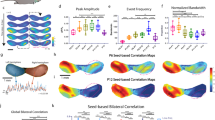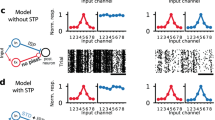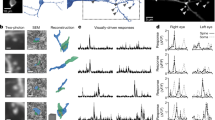Abstract
Functional receptive fields of neurons in sensory cortices undergo progressive refinement during development1,2,3,4. Such refinement may be attributed to the pruning of non-optimal excitatory inputs, reshaping of the excitatory tuning profile through modifying the strengths of individual inputs, or strengthening of cortical inhibition. These models have not been directly tested because of the technical difficulties in assaying the spatiotemporal patterns of functional synaptic inputs during development. Here we apply in vivo whole-cell voltage-clamp recordings to the recipient layer 4 neurons in the rat primary auditory cortex (A1) to determine the developmental changes in the frequency–intensity tonal receptive fields (TRFs) of their excitatory and inhibitory inputs. Surprisingly, we observe co-tuned excitation and inhibition immediately after the onset of hearing, suggesting that a tripartite thalamocortical circuit with relatively strong feedforward inhibition is formed independently of auditory experience. The frequency ranges of tone-driven excitatory and inhibitory inputs first expand within a few days of the onset of hearing and then persist into adulthood. The latter phase is accompanied by a sharpening of the excitatory but not inhibitory frequency tuning profile, which results in relatively broader inhibitory tuning in adult A1 neurons. Thus the development of cortical synaptic TRFs after the onset of hearing is marked by a slight breakdown of previously formed excitation–inhibition balance. Our results suggest that functional refinement of cortical TRFs does not require a selective pruning of inputs, but may depend more on a fine adjustment of excitatory input strengths.
This is a preview of subscription content, access via your institution
Access options
Subscribe to this journal
Receive 51 print issues and online access
$199.00 per year
only $3.90 per issue
Buy this article
- Purchase on Springer Link
- Instant access to full article PDF
Prices may be subject to local taxes which are calculated during checkout




Similar content being viewed by others
References
Katz, L. C. & Shatz, C. J. Synaptic activity and the construction of cortical circuits. Science 274, 1133–1138 (1996)
Fagiolini, M., Pizzorusso, T., Berardi, N., Domenici, L. & Maffei, L. Functional postnatal development of the rat primary visual cortex and the role of visual experience: dark rearing and monocular deprivation. Vision Res. 34, 709–720 (1994)
Zhang, L. I., Bao, S. & Merzenich, M. M. Persistent and specific influences of early acoustic environments on primary auditory cortex. Nature Neurosci. 4, 1123–1130 (2001)
Inan, M. & Crair, M. C. Development of cortical maps: perspectives from the barrel cortex. Neuroscientist 13, 49–61 (2007)
Hensch, T. K. Critical period plasticity in local cortical circuits. Nature Rev. Neurosci. 6, 877–888 (2005)
Chang, E. F. & Merzenich, M. M. Environmental noise retards auditory cortical development. Science 300, 498–502 (2003)
Zhang, L. I., Tan, A. Y., Schreiner, C. E. & Merzenich, M. M. Topography and synaptic shaping of direction selectivity in primary auditory cortex. Nature 424, 201–205 (2003)
Wehr, M. & Zador, A. M. Balanced inhibition underlies tuning and sharpens spike timing in auditory cortex. Nature 426, 442–446 (2003)
Tan, A. Y., Zhang, L. I., Merzenich, M. M. & Schreiner, C. E. Tone-evoked excitatory and inhibitory synaptic conductances of primary auditory cortex neurons. J. Neurophysiol. 92, 630–643 (2004)
Wu, G. K., Arbuckle, R., Liu, B. H., Tao, H. W. & Zhang, L. I. Lateral sharpening of cortical frequency tuning by approximately balanced inhibition. Neuron 58, 132–143 (2008)
Douglas, R. J. & Martin, K. A. A functional microcircuit for cat visual cortex. J. Physiol. 440, 735–769 (1991)
Oswald, A. M., Schiff, M. L. & Reyes, A. D. Synaptic mechanisms underlying auditory processing. Curr. Opin. Neurobiol. 16, 371–376 (2006)
Tao, H. W. & Poo, M. M. Activity-dependent matching of excitatory and inhibitory inputs during refinement of visual receptive fields. Neuron 45, 829–836 (2005)
Blatchley, B. J., Cooper, W. A. & Coleman, J. R. Development of auditory brainstem response to tone pip stimuli in the rat. Brain Res. 429, 75–84 (1987)
Geal-Dor, M., Freeman, S., Li, G. & Sohmer, H. Development of hearing in neonatal rats: air and bone conducted ABR thresholds. Hear. Res. 69, 236–242 (1993)
Chapman, B., Stryker, M. P. & Bonhoeffer, T. Development of orientation preference maps in ferret primary visual cortex. J. Neurosci. 16, 6443–6453 (1996)
Katz, L. C. & Crowley, J. C. Development of cortical circuits: lessons from ocular dominance columns. Nature Rev. Neurosci. 3, 34–42 (2002)
Romand, R. Modification of tonotopic representation in the auditory system during development. Prog. Neurobiol. 51, 1–17 (1997)
Dorrn, A. L., Yuan, K., Barker, A. J., Schreiner, C. E. & Fromke, R. C. Developmental sensory experience balances cortical excitation and inhibition. Nature 10.1038/nature09119 (this issue)
de Villers-Sidani, E., Chang, E. F., Bao, S. & Merzenich, M. M. Critical period window for spectral tuning defined in the primary auditory cortex (A1) in the rat. J. Neurosci. 27, 180–189 (2007)
Moore, C. I. & Nelson, S. B. Spatio-temporal subthreshold receptive fields in the vibrissa representation of rat primary somatosensory cortex. J. Neurophysiol. 80, 2882–2892 (1998)
Margrie, T. W., Brecht, M. & Sakmann, B. In vivo, low-resistance, whole-cell recordings from neurons in the anaesthetized and awake mammalian brain. Pflügers Arch. 444, 491–498 (2002)
Liu, B. H., Wu, G. K., Arbuckle, R., Tao, H. W. & Zhang, L. I. Defining cortical frequency tuning with recurrent excitatory circuitry. Nature Neurosci. 10, 1594–1600 (2007)
Zhou, Y. et al. Preceding inhibition silences layer 6 neurons in auditory cortex. Neuron 65, 706–717 (2010)
Liu, B. H. et al. Visual receptive field structure of cortical inhibitory neurons revealed by two-photon imaging guided recording. J. Neurosci. 29, 10520–10532 (2009)
Liu, B. H. et al. Intervening inhibition underlies simple-cell receptive field structure in visual cortex. Nature Neurosci. 13, 89–96 (2010)
Smith, P. H. & Populin, L. C. Fundamental differences between the thalamocortical recipient layers of the cat auditory and visual cortices. J. Comp. Neurol. 436, 508–519 (2001)
Richardson, R. J., Blundon, J. A., Bayazitov, I. T. & Zakharenko, S. S. Connectivity patterns revealed by mapping of active inputs on dendrites of thalamorecipient neurons in the auditory cortex. J. Neurosci. 29, 6406–6417 (2009)
Borg-Graham, L. J., Monier, C. & Frégnac, Y. Visual input evokes transient and strong shunting inhibition in visual cortical neurons. Nature 393, 369–373 (1998)
Anderson, J. S., Carandini, M. & Ferster, D. Orientation tuning of input conductance, excitation, and inhibition in cat primary visual cortex. J. Neurophysiol. 84, 909–926 (2000)
Somers, D. C., Nelson, S. B. & Sur, M. An emergent model of orientation selectivity in cat visual cortical simple cells. J. Neurosci. 15, 5448–5465 (1995)
Acknowledgements
We thank J. R. Chan for suggestions. This work was supported by grants to L.I.Z. from the US National Institutes of Health/National Institute on Deafness and Other Communication Disorders (R01DC008983, R21DC008588), the Searle Scholar Program, the Klingenstein Foundation and the David and Lucile Packard Foundation (Packard Fellowships for Science and Engineering). H.W.T. is supported by the US National Institutes of Health (EY018718 and EY019049) and the Karl Kirchgessner Foundation. Z.X. is supported by the National Natural Science Foundation of China (grant numbers 30730039, 30970982 and 30670665).
Author information
Authors and Affiliations
Contributions
Y.J.S., G.K.W., P.L. and M.Z. performed the experiments. Y.J.S. and B.-h.L. analysed the data. Z.X., H.W.T. and L.I.Z. designed the experiments and analysis. H.W.T. and L.I.Z. wrote the manuscript.
Corresponding authors
Ethics declarations
Competing interests
The authors declare no competing financial interests.
Supplementary information
Supplementary Figures
This file contains Supplementary Figures 1-3 with legends. (PDF 137 kb)
Rights and permissions
About this article
Cite this article
Sun, Y., Wu, G., Liu, Bh. et al. Fine-tuning of pre-balanced excitation and inhibition during auditory cortical development. Nature 465, 927–931 (2010). https://doi.org/10.1038/nature09079
Received:
Accepted:
Issue Date:
DOI: https://doi.org/10.1038/nature09079
This article is cited by
-
The relation between parietal GABA concentration and numerical skills
Scientific Reports (2021)
-
Corticostriatal control of defense behavior in mice induced by auditory looming cues
Nature Communications (2021)
-
Spatially extended balanced networks without translationally invariant connectivity
The Journal of Mathematical Neuroscience (2020)
-
Regional transcriptome analysis of AMPA and GABAA receptor subunit expression generates E/I signatures of the human brain
Scientific Reports (2020)
-
Increased cortical reactivity to repeated tones at 8 months in infants with later ASD
Translational Psychiatry (2019)
Comments
By submitting a comment you agree to abide by our Terms and Community Guidelines. If you find something abusive or that does not comply with our terms or guidelines please flag it as inappropriate.



